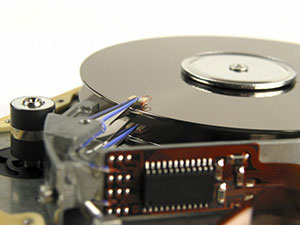| Nov 07, 2012 |
Data storage: How magnetic recording heats up
|
|
(Nanowerk News) Most electronic data is stored on magnetic hard drives that spin at many thousands of revolutions per minute. To keep pace with ever-growing storage demand, however, achieving greater storage capacities by simply increasing the size of disks is infeasible. The required spinning speed would put immense physical strain on the components, particularly on the writing ‘head’ — a small needle-like object used to write data at particular points on the disk (see image).
|
 |
| Applying heat during magnetic recording can improve storage densities far beyond their current levels. (©iStockphoto/Thinkstock)
|
|
An alternative technology, heat-assisted magnetic recording (HAMR), is now a significant step closer to commercial realization, thanks to the efforts of Baoxi Xu and his co-workers at the A*STAR Data Storage Institute, Singapore ("Thermal issues and their effects on heat-assisted magnetic recording system"). In a system using HAMR, laser light is emitted from a diode on the write head to locally heat the disk during data writing. This technique has the potential to increase a standard disk’s recording density by as much as two orders of magnitude. However, the additional heat can cause components such as the write head to destabilize and fall out of alignment.
|
|
By studying the temperature increase of the head, the thermal effects on the disk and the thermal response of the lubricant in HAMR, Xu and his co-workers discovered how to maximize the recording density of the medium. They began by establishing the three major heat sources present in the device: the laser diode, the optical transducer, which concentrates the incident light into a nanometer-sized spot, and the write pole, which performs the physical recording.
|
|
They found that the temperature of the transducer depends on both its size and distance from the write pole — both of which can be easily controlled in a commercial device. They also found that the temperature rise in the HAMR head does not significantly inhibit the performance of the laser diode, which is important.
|
|
Xu and his team’s results showed that the recording density of the medium can be maximized by reducing the number of layers through which the heat energy must pass before it can dissipate. This will be of prime importance for achieving the required high-density data storage goals of commercial devices. This study therefore represents an important breakthrough in our understanding of HAMR, and will be essential in bringing this technology closer to commercial fruition.
|
|
“Our work indicates the seriousness of the problems in the HAMR head, which gives a reference for HAMR design, and also provides a direction for improving thermal structures for high-density HAMR recording,” Xu says.
|

